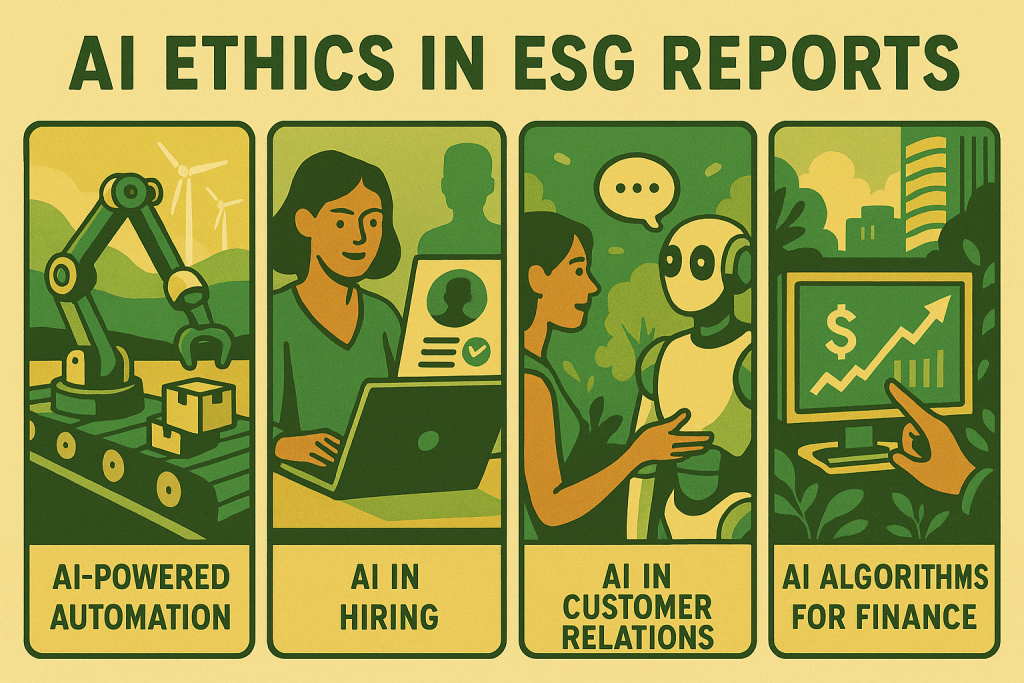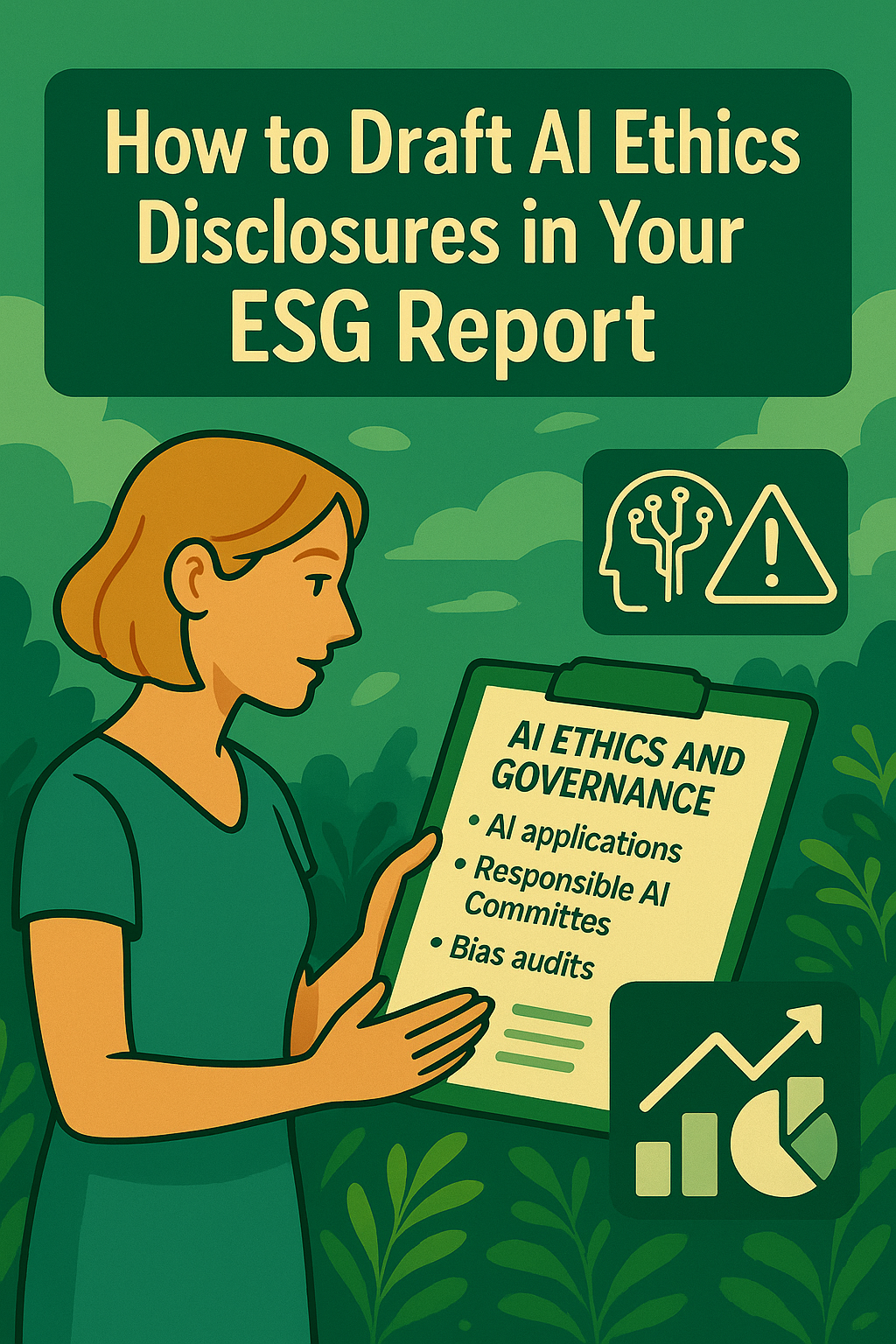Why AI Ethics Deserves a Section in Your ESG Report
Artificial Intelligence is no longer an experimental tool. It’s everywhere — in hiring, logistics, finance, product design, even ESG reporting itself.
That’s why ESG reports can’t ignore it anymore.
Including AI ethics disclosures in your ESG report isn’t just a “nice-to-have” — it’s becoming a stakeholder expectation, a compliance consideration (see: EU AI Act), and a reputational safeguard.
But how do you actually draft these disclosures?
This guide breaks it down with templates, examples, and best practices by AI use case.
What to Include: AI Ethics in ESG Reports
Your ESG disclosure should show:
- Where AI is used in your organization
- How it’s governed (committees, policies, oversight)
- Risks and mitigations (bias, fairness, energy use, transparency)
- Metrics or actions taken during the reporting period
Example Disclosures by AI Use Case
Let’s break it down by department or application.

HR / Talent Acquisition
Use Case: Resume screening algorithm and candidate ranking
Sample ESG Disclosure:
“We use/deployed an AI-powered candidate screening tool across our global hiring platform. A third-party audit was conducted to assess potential bias in candidate scoring based on gender and ethnicity. After identifying a disproportionate drop-off rate for women in technical roles, we adjusted the training data and reweighted scoring variables. Our Responsible Hiring AI Policy was updated accordingly.”
Finance / Credit Scoring
Use Case: AI-based credit risk models for B2B underwriting
Sample ESG Disclosure:
“Our credit assessment algorithms are reviewed quarterly for explainability and compliance with our Fair Finance Framework. In 2024, we introduced a ‘human-in-the-loop’ override mechanism for flagged scores. Additionally, we now disclose high-impact model decisions to customers and provide an opt-out path for manual review.”
Sustainability / ESG Automation
Use Case: AI model estimates Scope 3 emissions from supplier data
Sample ESG Disclosure:
“To improve the accuracy of our Scope 3 emissions reporting, we used a machine learning model trained on third-party databases and procurement records. The model’s assumptions and margin-of-error were disclosed in our CDP submission. We included a 3% buffer for uncertainty and plan to validate outputs annually via third-party carbon auditors.”
Supply Chain / Procurement
Use Case: Automated supplier risk detection and ESG scoring
Sample ESG Disclosure:
“We use AI models to assess supplier ESG risks based on public disclosures, news sentiment, and certifications. To mitigate false positives, our system flags high-risk cases for manual review by our sourcing team. In 2024, we declined partnerships with 11 vendors due to sustainability violations detected via the system.”
Legal / Compliance / Governance
Use Case: AI-powered document review for regulatory compliance
Sample ESG Disclosure:
“AI tools are used for contract analysis and regulatory keyword flagging. All outputs are reviewed by legal counsel. No automated decisions are made without human sign-off. We are evaluating ISO/IEC 42001 certification to formalize our AI governance framework.”
Internal Reporting / AI in ESG Software
Use Case: ESG dashboard powered by AI for risk heatmaps
Sample ESG Disclosure:
“Our ESG risk dashboard uses AI to classify and rank sustainability risks across our operations. Models are reviewed quarterly for data quality and are not used to make compliance-level decisions. Transparency metrics (e.g., data source lineage, model version, and training date) are now included in internal reporting logs.”
Template for Reporting AI Ethics in ESG
You can use this basic structure in your next ESG report:
markdownCopyEdit### AI Ethics and Governance
In FY2025, we deployed AI systems in the following operational areas:
- [List AI applications: e.g., hiring, emissions estimation, risk scoring]
To ensure responsible AI use, we implemented the following safeguards:
- Internal oversight: [e.g., Responsible AI Committee, board review]
- External review: [e.g., bias audits, model assurance partners]
- Human accountability: [e.g., no automated decisions without human sign-off]
Key actions taken:
- [Example: Updated fairness metrics in hiring model]
- [Example: Added explainability tool for internal AI dashboards]
- [Example: Reduced carbon intensity of model training by 22%]
Planned improvements for FY2026:
- [Example: Adopt ISO/IEC 42001 for AI governance]
- [Example: Publicly disclose model logic summaries for high-risk use cases]
Avoid These Common Mistakes
| Mistake | Why It’s a Problem | Fix |
|---|---|---|
| Vague language (“we use AI responsibly”) | Lacks credibility | Be specific—name the tools and actions taken |
| No metrics or oversight mentioned | Appears ungoverned | Include committees, audits, KPIs |
| Only technical, not social/environmental impacts | Ignores ESG lens | Frame in terms of fairness, trust, sustainability |
Final Word
AI will define the future of how companies operate — and how they are judged. ESG reports are now a key place to prove that your AI isn’t just powerful — it’s responsible, fair, and aligned with stakeholder values.
The best time to start was last year.
The second-best time is your next ESG report.



